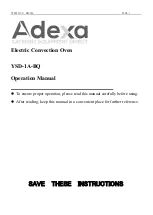
en
Tested for you in our cooking studio
44
Vegetables
Fill the jars with the vegetables along with hot, boiled
water.
Wipe the rims of the jars, as they must be clean. Place
a damp rubber ring and a lid on each jar. Seal the jars
with clamps. Place the jars into the universal pan so
that they do not touch each other. Pour 500 ml hot
water (approx. 80 °C) into the universal pan. Use the
settings indicated in the table.
Ending the preserving process
Fruit
After a short while, small bubbles will form at short
intervals. Switch off the appliance once all preserving
jars are bubbling. Remove the jars from the cooking
compartment after the indicated cooling time.
Vegetables
After a short while, small bubbles will form at short
intervals. As soon as all preserving jars are bubbling,
reduce the temperature to 120 °C and allow the jars to
continue to bubble in the closed cooking compartment
as indicated in the table. After this time has elapsed,
switch off the appliance and make use of the residual
heat for several minutes as indicated in the table.
After preserving, remove the jars from the cooking
compartment and place them onto a clean cloth. Do not
place these hot jars onto a cold or damp surface, as
they may crack. Cover the preserving jars to protect
them from draughts. Only remove the clamps once the
jars are cold.
Recommended setting values
The indicated times in the settings table are average
values for preserving fruit and vegetables. They may be
influenced by room temperature, the number of jars,
quantity, heat and quality of the jar contents. The
specifications are based on 1-litre round jars. Before
you switch off the appliance or change the cooking
mode, check whether the contents of the jars are
bubbling as they should. The bubbling process starts
after approx. 30-60 minutes.
Type of heating used:
■
‚
CircoTherm hot air
Allowing the dough to prove at dough
proving setting
Yeast dough will prove considerably more quickly using
the "Dough proving" heating type than at room
temperature and does not dry out. Only start operation
when the cooking compartment has fully cooled down.
Always allow yeast dough to prove twice. Observe the
specifications in the settings tables for the 1st and 2nd
proving processes (dough fermentation and final
fermentation).
Dough fermentation
Pour 200 ml water onto the cooking compartment floor
for the dough fermentation.
Caution!
Surface damage
■
Never pour water into the hot cooking compartment.
The temperature change can cause damage to the
enamel.
■
Do not use distilled water. Use tap water only.
Place the dough into a heat-resistant bowl and place it
onto the wire rack. Use the settings indicated in the
table.
Do not open the appliance door during the proving
process, as moisture will escape. Do not cover the
dough.
Condensation builds during operation which steams up
the door pane. Wipe out the cooking compartment after
dough proving. Loosen any limescale with a little
vinegar and wipe with clean water.
Final fermentation
Place your baked item into the oven at the shelf position
indicated in the table.
If you want to preheat the oven, the final fermentation
takes place outside the appliance in a warm place.
Preserving
Cookware
Shelf posi-
tion
Type of
heating
Tempera-
ture in °C
Cooking time in mins.
Vegetables, e.g. carrots
1-litre preserving jars
1
‚
160-170
Before it starts bubbling:30-40
120
When it starts to bubble: 30-40
-
Residual heat: 30
Vegetables, e.g. cucumbers
1-litre preserving jars
1
‚
160-170
Before it starts bubbling: 30-40
-
Residual heat: 30
Stone fruit, e.g. cherries, damsons 1-litre preserving jars
1
‚
160-170
Before it starts bubbling:30-40
-
Residual heat:35
Pomes, e.g. apples, strawberries
1-litre preserving jars
1
‚
160-170
Before it starts bubbling:30-40
-
Residual heat: 25





































